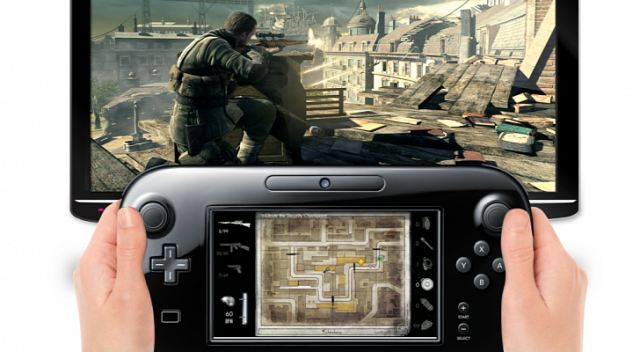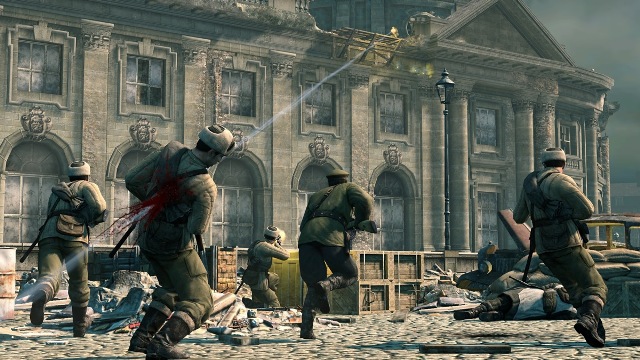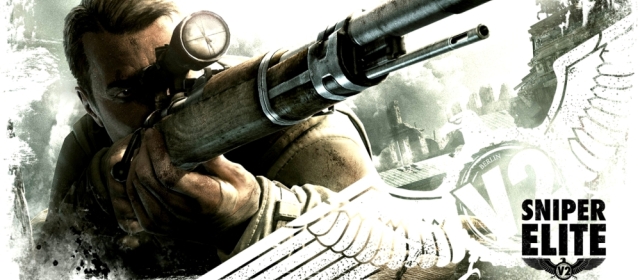Rebellion’s Sniper Elite V2 was released last year to a mixed response from critics. Our own UK Editor Adam Cook liked it enough to slap a big fat 9 on it, but others were less generous.
One of the biggest issues was the lack of variety in the admittedly-solid gameplay. While the sniping itself was considered to be great fun (and it really is), the framework around the sniping was seen by many to be somewhat lacking in pizazz. The more pedestrian running and gunning is hardly the stuff of legend, and outside of the rather excellent Slow Motion X-Ray Nazi Death Kill-Cam, Sniper Elite V2 lacks any real originality.
So, when news filtered through that Rebellion were preparing to bring the sniper sim to Nintendo’s newest console, with its gyroscope, accelerometer and secondary screen, the anticipation of potential new features was high. Unfortunately, Rebellion haven’t really gone to too much trouble with the Wii U version, playing it safe and avoiding any potential cock-ups by keeping the additional gameplay features to a minimum. It may be the safe and sensible option, but it’s also very disappointing from a consumer’s point of view.

The story and structure remain exactly the same, so you’ll still be playing as Karl Fairburne, an elite World War II sniper (of course) tasked with taking down the Nazi War Machine one bullet at a time. Sadly, the awesome “Assassinate the Fuhrer” expansion isn’t included, so you don’t get the chance to blast a hole through Hitler’s one remaining testicle in this version – although there’s every chance that both single player and multiplayer DLC packs will be released at some point in the future.
What the Wii U version does bring to the table is a handful of cool (though unessential) additions to the standard mechanics. “Mirrored Gameplay” is a fancy way of saying you can play it using the GamePad as the main screen, which, if we’re honest, is still one of the best features of any Wii U game that allows it. Being able to sit and play through a full-sized game on the GamePad while you’re other half watches telly or even plays another console on your TV is great.
One of the most useful additions is the new map-screen. As with many Wii U ports, the GamePad’s main screen now displays a permanent tactical map, made even more useful in Sniper Elite V2 thanks to the fact that you can now see any enemy you’ve tagged with your binoculars on the layout. It makes planning your one-man assaults much easier, especially as it also keeps tabs on any explosive traps you’ve laid and even displays their blast radius. For those tackling the game on it’s highest difficulty with all the help functions disabled, it’s an absolutely essential tool that will save your life time and again.

Controlling Fairburne is the same as it was on other consoles with the addition of instant weapon changes via the touchscreen. Sniping is also completely unchanged besides the fact that Fairburne’s heart-rate is displayed at all times so you don’t need to look through the scope to see if he’s close to a heart attack (he won’t actually have a coronary, but a raised heart-rate makes aiming very difficult). While the sniping retains the tactical depth and precision from other versions, it’s a great shame to see the GamePad so underused. Ubisoft’s excellent launch title, ZombiU, showed just what the swanky peripheral is capable of, and a sniper sim would seem the perfect fit for its accelerometer and panoramic capabilities. Being able to use the GamePad as a real-time sniper scope would have elevated this port into the realms of the Must-Have, but sadly it was not to be. Instead, Rebellion have left the sniping mechanic almost entirely as it was.
The co-operative multiplayer mode has also seen no significant overhauls, and a secondary single-player mode that essentially pits you against the same waves of enemies but on your own is a pointless inclusion – though it does make for some reflex-sharpening target practice.
Graphically, there’s no difference between the Wii U port and the original versions. The aesthetic fidelity is still incredibly erratic, occasionally dazzling with its detail and use of lighting, while at other times appearing drab and lifeless (particularly in the character models). Also, little has been done to eradicate the plague of bugs and glitches. The Kill-Cam still messes with the collision detection and the rag-doll physics, and texture pop-in and dodgy “corpse air-time” are still evident, though not common (I found several floating cadavers in one area after a particularly lengthy shoot-out).

Should you buy it?
If you own, or have completed, any of the original versions, there is absolutely nothing in the Wii U port that justifies a purchase. That being said, if this is a game that has so far passed you by, then this is absolutely the version you should buy. It doesn’t bring anything truly new to the game, but the additional features do add a deeper tactical element and increase the sense of satisfaction when you annihilate a plaza-full of Nazis without taking a single shot in your direction. The Kill-Cam remains a cathartic joy that simply never becomes tiresome, and the option to play the whole game on the smaller GamePad screen is, as always, a wonderful feature.
It’s a shame that Rebellion didn’t take more risks with the Wii U’s unique functionalities, but that they had faith enough to bring a version of their most popular game to Nintendo’s console bodes well for future instalments in the franchise.





